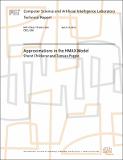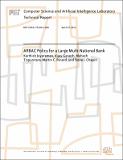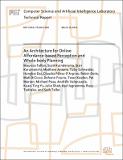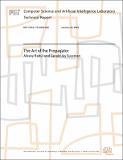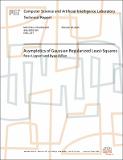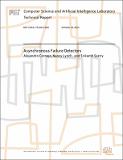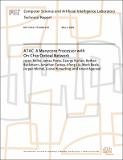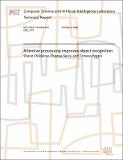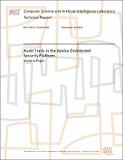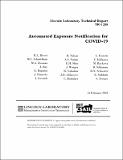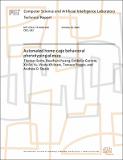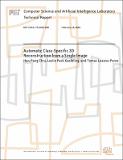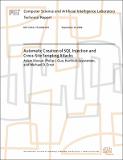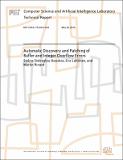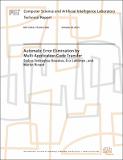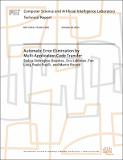Browsing CSAIL Technical Reports (July 1, 2003 - present) by Title
Now showing items 60-79 of 775
-
Approximations in the HMAX Model
(2011-04-14)The HMAX model is a biologically motivated architecture for computer vision whose components are in close agreement with existing physiological evidence. The model is capable of achieving close to human level performance ... -
ARBAC Policy for a Large Multi-National Bank
(2011-04-27)Administrative role-based access control (ARBAC) is the first comprehensive administrative model proposed for role-based access control (RBAC). ARBAC has several features for designing highly expressive policies, but current ... -
An Architecture for Online Affordance-based Perception and Whole-body Planning
(2014-03-16)The DARPA Robotics Challenge Trials held in December 2013 provided a landmark demonstration of dexterous mobile robots executing a variety of tasks aided by a remote human operator using only data from the robot's sensor ... -
The Art of the Propagator
(2009-01-26)We develop a programming model built on the idea that the basic computational elements are autonomous machines interconnected by shared cells through which they communicate. Each machine continuously examines the cells it ... -
Asymptotics of Gaussian Regularized Least-Squares
(2005-10-20)We consider regularized least-squares (RLS) with a Gaussian kernel. Weprove that if we let the Gaussian bandwidth $\sigma \rightarrow\infty$ while letting the regularization parameter $\lambda\rightarrow 0$, the RLS solution ... -
Asynchronous Failure Detectors
(2013-01-30)Failure detectors -- oracles that provide information about process crashes -- are an important abstraction for crash tolerance in distributed systems. The generality of failure-detector theory, while providing great ... -
Asynchronous Failure Detectors
(2013-10-10)Failure detectors -- oracles that provide information about process crashes -- are an important abstraction for crash tolerance in distributed systems. The generality of failure-detector theory, while providing great ... -
ATAC: A Manycore Processor with On-Chip Optical Network
(2009-05-05)Ever since industry has turned to parallelism instead of frequency scaling to improve processor performance, multicore processors have continued to scale to larger and larger numbers of cores. Some believe that multicores ... -
Attentive processing improves object recognition
(2009-10-02)The human visual system can recognize several thousand object categories irrespective of their position and size. This combination of selectivity and invariance is built up gradually across several stages of visual processing. ... -
Audit Trails in the Aeolus Distributed Security Platform
(2010-09-29)This thesis provides a complete design and implementation of audit trail collection and storage for Aeolus, a distributed security platform based on information flow control. An information flow control system regulates ... -
Automated Audio-visual Activity Analysis
(2005-09-20)Current computer vision techniques can effectively monitor gross activities in sparse environments. Unfortunately, visual stimulus is often not sufficient for reliably discriminating between many types of activity. In ... -
Automated Exposure Notification for COVID-19
(2023-02-22)Private Automated Contact Tracing (PACT) was a collaborative team and effort formed during the beginning of the Coronavirus Disease 2019 (COVID-19) pandemic. PACT’s mission was to enhance contact tracing in pandemic response ... -
Automated home-cage behavioral phenotyping of mice
(2009-10-26)We describe a trainable computer vision system enabling the automated analysis of complex mouse behaviors. We provide software and a very large manually annotated video database used for training and testing the system. ... -
Automatic Class-Specific 3D Reconstruction from a Single Image
(2009-02-18)Our goal is to automatically reconstruct 3D objects from a single image, by using prior 3D shape models of classes. The shape models, defined as a collection of oriented primitive shapes centered at fixed 3D positions, can ... -
Automatic Creation of SQL Injection and Cross-Site Scripting Attacks
(2008-09-10)We present a technique for finding security vulnerabilitiesin Web applications. SQL Injection (SQLI) and cross-sitescripting (XSS) attacks are widespread forms of attackin which the attacker crafts the input to the application ... -
Automatic Discovery and Patching of Buffer and Integer Overflow Errors
(2015-05-26)We present Targeted Automatic Patching (TAP), an automatic buffer and integer overflow discovery and patching system. Starting with an application and a seed input that the application processes correctly, TAP dynamically ... -
Automatic Error Elimination by Horizontal Code Transfer Across Multiple Applications
(2015-04-15)We present Code Phage (CP), a system for automatically transferring correct code from donor applications into recipient applications that process the same inputs to successfully eliminate errors in the recipient. Experimental ... -
Automatic Error Elimination by Multi-Application Code Transfer
(2014-10-02)We present pDNA, a system for automatically transfer- ring correct code from donor applications into recipient applications to successfully eliminate errors in the recipient. Experimental results using six donor applications ... -
Automatic Error Elimination by Multi-Application Code Transfer
(2014-09-30)We present pDNA, a system for automatically transfer- ring correct code from donor applications into recipient applications to successfully eliminate errors in the recipient. Experimental results using six donor applications ... -
Automatic Error Elimination by Multi-Application Code Transfer
(2014-08-11)We present pDNA, a system for automatically transferring correct code from donor applications into recipient applications to successfully eliminate errors in the recipient. Experimental results using three donor applications ...

